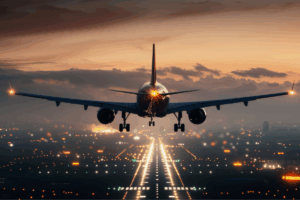Since the first runway became operational over a century ago, airport lighting technology has taken off, increasing safety and improving runway efficiency with new innovations that continue to revolutionize our industry.
Advancements such as LEDs, runway edge lights, airport lighting control and management systems (ALCMS), precision approach path indicators (PAPI), and other innovations have transformed how airports manage aircraft traffic. However, new technologies, such as automated surface detection equipment (ASDE), are being increasingly integrated with airport lighting systems to help improve safety and efficiency even more.
What Is Automated Surface Detection Equipment (ASDE)?
ASDEs provide real-time monitoring of aircraft and transponder-equipped vehicles on runways and taxiways, allowing air traffic controllers to detect potential conflicts and take appropriate action to avoid collisions.
In 2003, the first ADSE, known as the ASDE-X, was installed in the United States at General Mitchell International Airport in Milwaukee. By 2011, the FAA had rolled out the technology to the top 35 American airports.
These systems work by gathering vehicle movement by combining several different technologies, including:
- Radar systems that operate in the millimeter-wave frequency range, allowing them to detect objects regardless of weather conditions
- Aircraft transponders that broadcast the aircraft’s position, speed, and other data to ground personnel
- Multilateration sensors that use signals from aircraft transponders to accurately pinpoint their location on the airport surface by calculating the time difference between the arrival signals at different sensor locations
The data collected by these technologies is processed and displayed on color monitors to give air traffic controllers a real-time, bird’s-eye view of the airport surface. The display highlights the exact location and identification of air and ground vehicles on runways, taxiways, and approach corridors. It also detects and reports on aircraft flying within five miles of the airport.
Integrating Automated Surface Detection Equipment With Airport Lighting Systems
Engineers who develop airport lighting systems understand the critical need for seamless integration between technologies for cross-platform communication and reporting to system operators. That’s why ASDEs are designed to interface with runway lighting controls, providing reliable, automated accident-avoidance response.
For example, if the ASDE detects the presence and movement of aircraft or vehicles, it can dynamically control the lighting on the runway or taxiway, increasing the light’s intensity as the object approaches and dimming it once the object has passed.
Additionally, these systems can respond dynamically to potential safety risks by triggering alarms and adjusting lighting accordingly. For example, if the ASDE detects that an aircraft is moving on the wrong runway or taxiway, it can automatically flash runway edge lights or activate other lights to alert pilots and air traffic controllers of the potential hazard, allowing them to take corrective action quickly.
ASDEs can also be integrated with stop bar systems. If the ASDE detects unusual or suspicious activity, such as an unauthorized vehicle or aircraft approaching an active runway, it can automatically raise or lower stop bars based on the object’s detected position and clearance status, preventing an incursion.
The situational awareness that ASDEs provide is critical in improving and maintaining airport safety and efficiency, especially in adverse weather or lighting conditions when pilots require extra support and guidance to navigate runways and taxiways safely.
Read More: Enhancing Airport Efficiency And Safety With Airport Lighting Control And Monitoring Systems
What Are The Benefits Of ASDEs To Airport Operations?
Without question, the primary benefit of integrating an automated surface detection equipment into your airport operation is safety, thanks to the system’s ability to provide dynamic and responsive lighting based on real-time surface movement data.
In addition, the automation features offered by ASDE systems significantly reduce reliance on manual input from air traffic controllers, minimizing the potential for human error that can lead to accidents, particularly in busy airports or airports with complex layouts and configurations. The system also helps personnel manage ground traffic more efficiently during peak periods, inclement weather, or low-light conditions.
Similarly, the ASDE system supports clear visual cues for pilots with dynamic lighting adjustments that help them maintain the correct runway alignment and avoid potential hazards during adverse weather or at night.
If you have questions about integrating your airport lighting systems with an ASDE, talk to the experts at Airport Lighting Company. We know that safety and performance are non-negotiable when it comes to your airport lighting and power equipment, and our technicians will always give you their best recommendations to ensure your runway and taxiway lighting operations are set up for success.
Call Airport Lighting Company For The Latest In Airport Lighting Technology
The Airport Lighting Company team is standing by to answer your questions about how our tech-based products can help improve the safety, reliability, and efficiency of your runways. Call 315-682-6460 for fast, friendly service you can count on.


